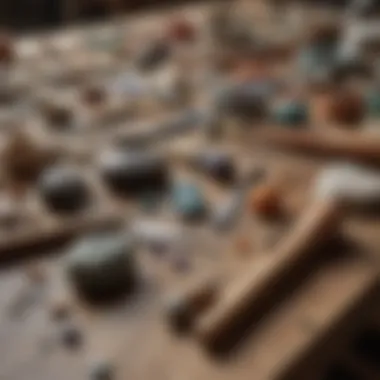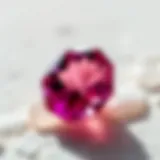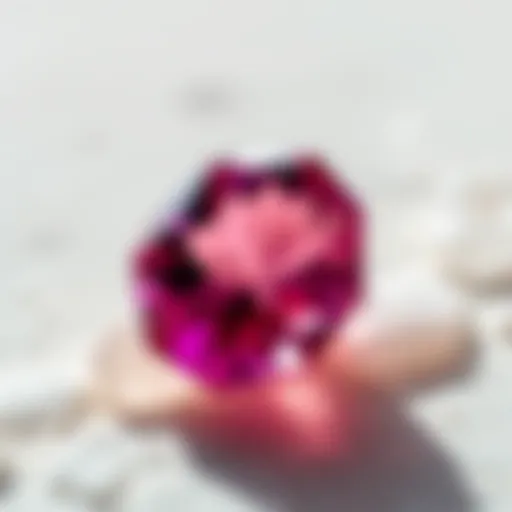Understanding Lapidary Training in the Gemstone Industry


Intro
The art of lapidary is not just about cutting and polishing gemstones; it’s a window into the rich tapestry of nature’s offerings. The fascination with stones goes back thousands of years, steeped in history and culture. In today's world, where the gemstone industry is thriving, understanding the nuances of lapidary training becomes paramount. This guide aims to navigate the intricate paths of lapidary, providing insights that are not only practical but also enriching.
By exploring the techniques, tools, and educational avenues available, we gain a clearer picture of what it takes to excel in this craft. Whether you are a budding artisan or a seasoned collector, there’s something in this for everyone.
Preamble to Lapidary Training
Lapidary training serves as the cornerstone for mastering the craftsmanship of gemstones. It’s not just a learning experience—it's an exploration into a world rich with beauty, history, and precision. Here, aspiring lapidaries are molded into artisans equipped with skills to transform rough stones into dazzling works of art.
Understanding lapidary work is crucial for anyone looking to delve into this sphere. The intricate process requires patience, a keen eye, and a deep appreciation for the materials worked with. Whether one aims to craft personal jewelry or become a designer on a larger scale, this training lays the foundation upon which all else is built. The techniques learned in lapidary training can set the stage for creativity and innovation, evolving the simple act of shaping stones into an expressive art form.
As each participant charts their journey, they will uncover not just the how but also the why behind lapidary work. This understanding elevates the skill from manual to meaningful—members of the gemstone community find themselves knee-deep in a tradition that dates back thousands of years. Training encapsulates all the techniques and knowledge passed down through generations, ensuring that the age-old artistry doesn’t fade away.
In essence, lapidary training isn't merely about working with stones; it’s about forging connections—both with the materials and the rich, cultural context of the craft. There is a profound importance to this endeavor, centering around the need for skilled professionals who respect both tradition and innovation.
Understanding Lapidary Work
Lapidary work is the art of cutting, shaping, and polishing stones and gems to create jewelry or decorative objects. At its core, it blends science with art. Gemstones like diamonds, rubies, and sapphires undergo elaborate transformations, each requiring specialized techniques and tools. To truly appreciate the craft, one must grasp its many layers, from selecting the right stone to the delicate nuances of the final polish.
This process has existed for centuries, with origins rooted in ancient civilizations. It’s fascinating to consider how the early artisans relied on rudimentary tools, yet developed stunning pieces that evoke awe even today. Modern lapidaries have access to an array of tools that streamline and enhance the work process, yet the fundamental principles remain remarkably unchanged.
A lapidary's toolkit may include
- diamond blades for cutting,
- various grinding wheels for shaping,
- polishing compounds,
- and safety equipment to protect against dust and debris.
Each tool plays an integral role, allowing craftsmen to put their creative vision onto the stone.
Importance of Training in the Field
Training is indispensable in the lapidary field. Without it, even the most passionate hobbyist might struggle to navigate the complexities of gemstone manipulation. A well-structured training program offers not just technical skills but also insights into the market trends, gemstone identification, and ethical practices.
Tough choices can arise, particularly when it comes to sourcing. Knowledge gained during training helps budding lapidaries understand the significance of ethical sourcing and environmental concerns. Through case studies, workshops, and hands-on practice, trainees learn to be not just artisans, but stewards of the planet’s resources.
In summary, the importance of training cannot be overstated. It is what fosters both individual talent and collective growth within the gemstone industry. Emerging artists become equipped not just with skills, but with the perspectives needed to thrive and innovate. With the ever-evolving market, those who grasp the importance of continuous learning will emerge as the leaders and visionaries of tomorrow.
Historical Context of Lapidary Craftsmanship
Understanding the historical context of lapidary craftsmanship is essential for appreciating the art's significance today. The practices of cutting, shaping, and polishing gems have evolved over centuries, often reflecting the culture, technology, and artistry of the time. By diving into the origins and the various stages of lapidary arts, enthusiasts can gain insights into not only the techniques used but also the human narratives that shaped these practices.
Throughout history, lapidary work has been intertwined with human civilization—each culture's interpretation of gemstones tells a story, highlighting their respective beliefs and technological advancements. This background sets the stage for present-day practices and innovations, bridging the gap between ancient craftsmanship and contemporary methods.
Origins of Lapidary Arts
The origins of lapidary arts can be traced back to ancient civilizations, where natural stones were utilized for tools and personal adornments. In Mesopotamia around 3000 BC, the early artisans began to recognize the beauty of naturally occurring stones. Features like lapis lazuli and carnelian were polished to create elegant pieces of jewelry and ornaments. This wasn't merely craftsmanship, but the birth of an art form rooted in aesthetics and utility. Over time, techniques began to refine; basic hand-held tools evolved into more sophisticated implements, facilitating a broader variety of shapes and finishes.
The ancient Egyptians were pioneers in lapidary work—using their knowledge of gemstones not only in jewelry but as symbols of power and protection in their burial practices. They believed that certain stones had mystical properties, thus influencing their selection of materials for items like scarabs and ceremonial pieces. The meticulous engraving seen on these objects reveals a sophisticated understanding of both form and function.
Evolution Through the Ages
From the glinting gems of Egypt to the detailed craftsmanship of the Italian Renaissance, lapidary arts have continued to grow and evolve. An impactful change came during the Middle Ages, when techniques, such as cabochon cutting, gained popularity in Europe. This period saw craftsmen developing and passing down methodical approaches to working with stones, establishing guilds that ensured that the knowledge of lapidary techniques was preserved and improved upon.
The emergence of the diamond industry during the 15th century was pivotal as well. It wasn't until specialized cutting methods, like the brilliant cut, were developed that diamonds could emit the sparkle they are known for today. This innovation ushered in a new era of demand for gemstone jewelry.
Fast forward to the modern era, technological advancements have transformed lapidary practices. Computer-aided design (CAD) and laser cutting tools have streamlined many processes, allowing for precision that was once impossible. Nevertheless, the essence of lapidary craftsmanship remains—an art deeply rooted in history, skill, and tradition. As society evolves, so too does the art of lapidary, weaving the past into the modern narrative of gemstone artistry, and ensuring its relevance for future generations.


"To understand the present, one must first explore the past. The artistry in lapidary work today draws significantly from centuries of craftsmanship that continues to inspire and shape the field."
In summary, the historical context of lapidary craftsmanship not only provides valuable background knowledge but also connects enthusiasts with the rich tapestry of human creativity and technological progression in the world of gemstones.
Essential Techniques in Lapidary Training
Understanding and mastering essential techniques in lapidary training serves as the cornerstone for anyone venturing into the art of gemstone craftsmanship. These techniques not only enhance the aesthetic appeal of gemstones but also underscore their intrinsic value. From shaping raw stones into mesmerizing jewels to perfecting their surface finish, each method encapsulates a wealth of knowledge and skill that reflects the dedication involved in this craft.
Cutting and Shaping Gemstones
Cutting and shaping are arguably the most critical skills in lapidary arts. This stage involves converting rough stones into beautiful gems. Using tools like diamond saws and grinders, lapidaries slice rough materials into desired shapes. Techniques such as cabochon cutting or faceting are employed based on the type of gemstone and the intended design.
The art lies in choosing the right angle and technique for each stone. For instance, quartz may be cut differently than sapphire due to their distinct hardness levels. The precision of each cut influences how light interacts with the stone, enhancing its brilliance and character.
Practicing this skill requires patience. The phrase "slow and steady wins the race" holds much truth here. Each misstep can lead to irreparable damage to a valuable gemstone. Therefore, learners must cultivate a habit of meticulous attention to detail during this process.
Polishing Techniques
After cutting and shaping, polishing is where the magic truly happens. Polishing not only brings out the beauty of gemstones but also protects them from external damage. Various methods and compounds are used depending on the hardness and type of stone being polished.
For instance, softer stones might be polished with a different abrasive, like cerium oxide, while harder stones could need something more robust, such as diamond paste. Many lapidaries employ techniques like buffering or tumbling to achieve a smooth, shiny finish.
The experience gained from polishing effectively teaches one about the mineral composition of stones. Both texture and lustrous surface finish play a vital role in a gemstone's appeal to buyers or collectors. Furthermore, polished stones tend to resist scratches and damage more efficiently, making them longer-lasting pieces of art.
Engraving and Inlay Work
Engraving and inlay work can elevate gemstone pieces from simple decorative items to true works of art. Engraving involves cutting designs or patterns into the surface of the stone, creating a unique visual depth that cannot be achieved through cutting or polishing alone. This technique often requires specialized equipment, like a rotary tool or a laser engraver, to achieve precision.
Inlay work, on the other hand, combines multiple gemstone pieces to create intricate patterns. This technique not only showcases the gem's color and beauty but also enhances its overall value. For example, inlaying turquoise with onyx can produce stunning contrasts that grab the viewer's attention.
Engraving and inlay work require a good deal of practice for perfection. They also teach invaluable lessons about artistic design and planning—choosing the right stones, considering one's audience, and often, understanding historical motifs or styles. Many lapidaries find joy in transforming their creative visions into tangible designs through these techniques.
"Each technique not only adds to the visual element of a gemstone but also represents a part of the story behind its creation."
Lapidary training is not merely a set of skills; rather, it is a journey through the intricacies and subtleties of the craft. By mastering these essential techniques, aspiring lapidaries can unlock endless possibilities, making their mark in the world of gemstone artistry.
Tools and Materials Used in Lapidary Training
In the world of lapidary, the tools and materials serve not merely as instruments but as extensions of the artisan’s intent. Each chisel, cutter, and grit plays a vital role in the craft, allowing the lapidary to transform rough stones into polished masterpieces. Understanding this intricacy is essential for anyone embarking on their lapidary journey. The right tools and materials can mean the difference between a mere hobbyist and a skilled craftsman.
Basic Equipment Overview
To make strides in lapidary work, a lapidary artist must invest in a basic toolbox complete with essential equipment. Here’s a list of fundamental tools you should consider:
- Saw: A lapidary saw is crucial for cutting rough materials into manageable pieces. The type can vary from a simple hand saw to more complex machine saws, such as a wet saw, which can cool the gemstone and avoid overheating.
- Grinder: This tool narrows in on shaping and smoothing stones, often multiple wheels are attachable, each with varying levels of abrasiveness.
- Polisher: After shaping, polishing wheels using diamond or other composite materials elevate the stone’s shine and luster.
- Drill: A lapidary drill is necessary for creating holes, often used in jewelry-making.
Each piece of equipment comes with its own learning curve, yet investing time and resources into mastering these tools pays off, helping artisans reach their full potential.
Safety Gear and Precautions
When dealing with machinery and semi-precious stones, safety shouldn't be an afterthought. Protection is a priority, and various gear must be donned to prevent mishaps:
- Safety Goggles: Protect your eyes from flying particles and dust.
- Dust Masks: These minimize inhalation of fine stone dust, which can be harmful.
- Gloves: Good fitting gloves can protect your hands from cuts and abrasions, as well as provide a better grip on tools.
In addition to protective gear, awareness is key. Ensure that equipment is set up in a well-ventilated space, enabling proper airflow while working. Routine inspections of tools and materials can mitigate risks; a blade with damage can result in injury during use. Prioritize safety to make your lapidary experience enjoyable and productive.
Types of Gemstones for Beginners


Starting in lapidary training, the choice of gemstones can set the stage for future projects. Beginners should consider the following stones:
- Agate: Its variety of colors and patterns offers an engaging starting point for cutting and polishing. It isn’t too hard, making it manageable for novices.
- Jasper: Similar to agate but typically more opaque, jasper can be creatively utilized in various designs.
- Quartz: Readily available and easy to work with, quartz can be a good introduction to various lapidary methods.
- Lapis Lazuli: This stone can challenge beginners and lift their skills, but requires careful handling.
It’s worth noting that selecting gemstones with varying hardness can help new artisans practice their skills. A balance between challenge and achievability encourages continued growth in lapidary training.
"The strength of a craft lies not only in the tools it uses but in the hands that wield them."
In a nutshell, the tools and materials in lapidary training are indispensable for emerging artisans. An informed choice and proper handling can lead to remarkable outcomes, paving the way for innovation and artistry in the craft.
Educational Pathways in Lapidary Training
The journey into lapidary training is as unique as the gemstones one learns to craft. Educational pathways in this field can shape the skills and knowledge a budding lapidary will acquire. Finding the right education method is crucial, whether through formal schooling, self-guided learning, or community workshops. Gaining insight into the options available is essential for anyone looking to delve deeper into the gemstone craft.
Formal Education vs. Self-Teaching
When envisioning a path through lapidary arts, one can either step into a classroom or embark on a solitary quest at home. Formal education programs often offer structured learning, covering all aspects from theoretical foundations to practical applications. Institutions might include local community colleges or specialized art schools that provide courses on lapidary techniques.
Formal programs often come with experienced instructors, allowing students to get instant feedback and guidance. They offer a comprehensive curriculum and even opportunities for networking with professionals in the industry. For instance, you might find yourself in a class polishing your first stone, with the instructor showing you the ins and outs on how to do it right.
On the flip side, self-teaching holds its charm. The beauty lies in the flexibility it offers. A gem-lover can choose any resource, from online video tutorials to books, based on personal preferences and grasping speed. Platforms such as Reddit can provide a wealth of knowledge from seasoned lapidaries who share their tricks of the trade. Plus, setting your own pace means you can spend as much time as needed on those tricky polishing techniques that may not be covered thoroughly in a classroom setting.
Ultimately, the choice between formal education and self-teaching boils down to personal goals, learning styles, and time commitment. Some might find that a blend of both is ideal, starting formally and then branching out to self-discovery.
Workshops and Community Resources
For people eager to learn about lapidary work without diving into a formal education, workshops and community resources serve as excellent stepping stones. Many local lapidary clubs offer workshops where enthusiasts gather to learn and share knowledge. These hands-on experiences are invaluable, as participants often work side by side with experienced jewelers or lapidaries.
The camaraderie found in workshops cultivates an environment of learning and growth. "There's something about learning alongside others that just clicks; it's a form of inspiration you can't get when you're all alone." You might hear tips and tricks whispered among peers that textbooks might overlook. Such workshops can cover anything from basic cutting skills to more advanced inlay techniques, often tailored to different experience levels.
Moreover, organizations such as the Gem and Mineral Society often provide access to tools and materials that would be otherwise hard to find for a novice working out of their garage. Not to mention, community resources might host open studio hours where you can practice skills in a collaborative setting, further enhancing your technique.
In summary, whether a person chooses formal education, opts for self-teaching, or seeks out community workshops, what’s essential is finding the route that resonates best with their aspirations in the lapidary world. Each pathway offers distinct benefits, ultimately contributing to a more rounded knowledge base and craftsmanship in lapidary endeavors.
Professional Opportunities in the Lapidary Field
The lapidary field isn't just a hands-on craft; it's a gateway to multiple professional avenues that can be both fulfilling and lucrative. As gemstone enthusiasts, collectors, and jewelry designers seek quality pieces, trained lapidaries stand at the forefront of the industry. The demand for skilled artisans who can masterfully cut, shape, and finish stones creates a vast landscape of opportunities.
For those considering a career in this craft, the choices often feel as sparkling as the gems themselves. Whether you yearn to work for a high-end jewelry line or aspire to start your own boutique, the path is rich with promise. Training in lapidary arts not only hones your technical skills but also connects you with a network of professionals eager to share their expertise.
Career Paths for Trained Lapidaries
In the realm of lapidary work, career paths are as diverse as the types of gemstones available. Here are some potential directions:
- Gem Cutter: This is the quintessential role. Gem cutters or lapidaries specialize in the precise cutting and shaping of various stones. Mastering this skill can lead to employment with jewelers or gemstone suppliers.
- Jewelry Designer: Many trained lapidaries also delve into jewelry design. This allows artisans to infuse personal creativity into their work, transforming rough stones into one-of-a-kind wearable art.
- Restoration Specialist: With a knack for history and preservation, some lapidaries focus on restoring antique jewelry. This role demands not only skills in lapidary techniques but also a keen understanding of gemstones and historical context.
- Appraiser: Experienced lapidaries can branch into appraisal, determining gemstone quality and value. This career often requires additional certification but can be extraordinarily rewarding, considering the potential worth of fine gems.
- Educator: For those who find joy in sharing knowledge, teaching lapidary skills can be a fulfilling path. Whether in formal institutions or community workshops, passing on skills can be a significant contribution to the craft.
Each of these avenues resonates with distinct skills and experiences. Transitioning among them is common as one's interests and expertise evolve over time.
Entrepreneurship in Gemstone Design
The entrepreneurial spirit is also alive and well in the lapidary field. With experience and skill, many lapidaries take the leap into starting their own businesses. Here’s what entering the entrepreneurial world offers:
- Creative Control: Owning a gemstone design business allows for full creative expression. You can create unique pieces that reflect personal style or cater to niche markets.
- Market Demand: The increase in consumer interest in artisanal and handcrafted jewelry presents a significant opportunity. Many buyers prefer unique pieces over mass-produced items, creating a niche for skilled lapidaries.
- Sustainable Practices: Increasing awareness of ethical sourcing means that trained lapidaries can carve a name for themselves by upholding sustainable practices. This not only caters to eco-conscious consumers but also elevates brand integrity.
- Networking Opportunities: Running your own business often leads to collaborations with other artisans, designers, and jewelry stores, expanding your reach and potential clientele.
- Digital Presence: The digital age allows lapidaries to market their creations globally. Platforms like Etsy or independent websites can facilitate sales, and social media can enhance visibility.
Engaging in entrepreneurship in gemstone design allows you to blend passion with commerce, which can be highly gratifying.
"A lapidary’s work is not merely cutting stones but also carving out one’s identity in a multifaceted market."


In summary, the professional landscape in the lapidary field brims with possibilities. Training lays the foundation for a rich career, whether you choose to join established enterprises or carve out your path as an entrepreneur. It's a world where gems represent more than just material; they symbolize the endless opportunities awaiting those dedicated to the craft.
Technological Advancements in Lapidary Techniques
In recent years, the lapidary trade has seen a remarkable transformation thanks to technological advancements. These developments have not only streamlined the process of shaping and polishing gemstones but have also opened up new avenues for creativity and precision that were previously unimaginable. In a world where time is often money, these innovations enable lapidaries to work smarter, not just harder, thus elevating the craft to new heights.
Modern Tools and Their Applications
Modern lapidary work relies heavily on an array of tools that make the processes of cutting, shaping, and polishing more efficient than ever. Some of the most significant advancements include:
- Laser Cutters: These machines provide unparalleled precision in cutting gemstones. Unlike traditional methods, lasers can produce intricate designs with minimal waste, allowing artisans to create unique shapes that enhance the stone's natural beauty.
- Diamond Abrasives: Utilizing diamond particles for grinding and polishing has revolutionized the quality of finishes on gemstones. These abrasives are durable and can cut through even the toughest materials, making them a staple for modern lapidaries.
- Computer Numerical Control (CNC) Machines: These programmable tools automate various processes, ensuring repeatability and efficiency. With a CNC machine, lapidaries can design complex patterns that would be labor-intensive to achieve by hand. This machinery not only speeds up production but also minimizes human error.
"Technology has changed the face of lapidary work, blending skill with innovation to create pieces that showcase the art in every facet."
- Polishing Machines: These machines, often equipped with multiple discs and variable speeds, allow lapidaries to achieve a high level of polish on their stones, enhancing their color and clarity. They are particularly beneficial for beginners, providing consistent results with less effort.
- Portable Lapidary Tools: With advancements in battery technology and compact designs, portable tools have become ideal for hobbyists and professionals alike. Whether it’s a small polishing kit or a handheld saw, these tools promote creativity and spontaneity, allowing artists to take their work wherever inspiration strikes.
Impact of Technology on Traditional Practices
While technology enhances the efficiency and precision of gemstone crafting, it brings forth considerations regarding the traditional practices that have defined lapidary work for centuries.
- Preservation of Craftsmanship: Some might argue that relying excessively on technology may compromise the hands-on skills that traditional lapidaries have honed over years. However, many artisans find that integrating technology into their workflow actually enhances their craftsmanship rather than replaces it. The key is to use modern tools as a means to further artistic expression.
- Adaptation and Upskilling: For seasoned lapidaries, the introduction of new technologies can be a double-edged sword. While it necessitates a learning curve and the need to adapt, it also offers opportunities for growth and specialization. The demand for digitally crafted pieces has led many to acquire new skills, bridging the gap between traditional artisanship and modern techniques.
- Market Evolution: The gemstone market has become increasingly competitive, and being adept with new technologies can provide an edge. Customers today often seek unique, high-quality pieces that reflect contemporary trends, and lapidaries who embrace these advancements position themselves better within the industry.
Sustainability in Lapidary Practices
In the lapidary field, sustainability isn’t just a buzzword; it’s a necessity. The processes involved in crafting gemstones often raise questions about ethical practices and environmental responsibility. As gemstone enthusiasts and collectors increasingly express concern for the planet, the importance of sustainable practices in lapidary training is coming to the fore. This section explores these critical aspects, highlighting how they shape the future of the craft and impact the global community.
Ethical Sourcing of Gemstones
The journey of a gemstone from its raw state to a beautifully polished piece is a complex one. Ethical sourcing is about ensuring that gemstones are acquired without causing harm to people or the environment. This includes:
- Fair Labor Practices: Lapidary practitioners must prioritize sourcing gemstones from suppliers who adhere to humane labor standards, ensuring workers are paid fairly and work in safe conditions. The harsh realities in some mines can’t be ignored, as the industry has faced scrutiny over exploitative practices.
- Conflict-Free Stones: Buyers should seek gemstones that are certified as conflict-free, which means they do not fund violence in war-torn regions. Organizations like the Kimberley Process work to prevent this issue, although the effectiveness of this initiative has come under question.
- Supporting Local Communities: Opting for stones sourced from local artisans supports communities, providing them with economic opportunities while promoting cultural heritage. This creates a win-win situation, where traditional craftsmanship is preserved, while local economies benefit.
Understanding these elements can lead lapidary enthusiasts to make informed decisions about the gemstones they choose to purchase.
Environmental Considerations
The lapidary craft, when practiced irresponsibly, can have a serious impact on local ecosystems. Here are some key environmental considerations:
- Mining Practices: Traditional mining techniques may lead to habitat destruction and soil erosion. It’s crucial to consider methods that minimize environmental disruption, such as using small-scale operations that reduce land footprint.
- Waste Management: The cutting and polishing processes generate significant waste. Adopting strategies for reusing or recycling materials can lessen the ecological footprint of lapidary practices. Proper disposal of hazardous materials is also essential to prevent contamination of local water sources.
- Sustainable Alternatives: Innovations such as lab-grown gemstones have gained traction. These stones often have less environmental impact and can be made without the ethical dilemmas surrounding mined gemstones. They provide an attractive alternative for those who wish to enjoy the beauty of gemstones while preserving environmental integrity.
"Embracing sustainability within the lapidary field not only protects the planet; it helps elevate the craft to a higher ethical standard."
By acknowledging the importance of sustainability, lapidary practitioners can help ensure that their craft contributes positively to society and the environment at large. This responsibility paves the way for a future where the beauty of gemstones is matched by the integrity of their sourcing and production. In the end, the choices made today will resonate through generations, influencing the gems that future artisans will shape.
Ending
The conclusion of this article serves as a vital summary that encapsulates the integral themes and insights discussed throughout. Engaging in lapidary training is not merely about honing a craft; it encompasses a whole lifestyle and philosophy that fosters appreciation for nature, art, and skill. The significance of mastering lapidary arts lies in how it bridges the gap between raw, uncut gemstones and exquisite jewelry or artistic pieces.
Summary of Key Points
- Understanding of Techniques: A deep dive into critical techniques such as cutting, polishing, and engraving has highlighted the meticulous nature of lapidary work. Each step requires patience, precision, and practice, underscoring its importance in producing high-quality results.
- Tools and Materials: From inexpensive starter kits to industrial-grade machinery, the article illustrated a comprehensive overview of tools that vary based on the level of expertise. Understanding how to utilize each tool contributes significantly to the lapidary process.
- Education and Community: The diverse educational pathways available—from formal training programs to online resources and community workshops—provide aspiring lapidaries with options to fit their lifestyle and learning preferences.
- Professional Opportunities: The potential career paths in the lapidary field offer much more than just crafting jewelry; they open doors to entrepreneurship, gemstone design, and conservation practices that affect both local economies and global markets.
- Sustainability Practices: In an era where ethical sourcing and environmental considerations are paramount, the lapidary world is making strides to source gemstones responsibly, ensuring the craft remains viable for future generations.
"Lapidary training is more than just a skill; it's a journey into the Earth's depths, transforming nature's beauty into timeless pieces."
Future of Lapidary Training
As we look ahead, the future of lapidary training appears bright, intertwined with technological advancements and a growing appreciation for handcrafted artistry. Innovations in machine learning and design software may shape how new artisans approach lapidary work, possibly simplifying the learning curve for beginners.
Moreover, as the emphasis on sustainability continues, there is likely to be a surge in demand for ethically sourced materials. Contemporary lapidaries may find themselves not only mastering their craft but also advocating for responsible practices that ensure the environment and communities involved in gemstone mining are respected and preserved.
The growing community of gemstone enthusiasts and artisans will drive further knowledge sharing, allowing for the evolution of techniques and appreciation of craftsmanship that is diverse and inclusive.
In summary, the rich tapestry of lapidary training serves as an exciting foundation for both personal exploration and professional development. As each gem is transformed, so too are the artisans and collectors who dedicate themselves to this exquisite craft.







